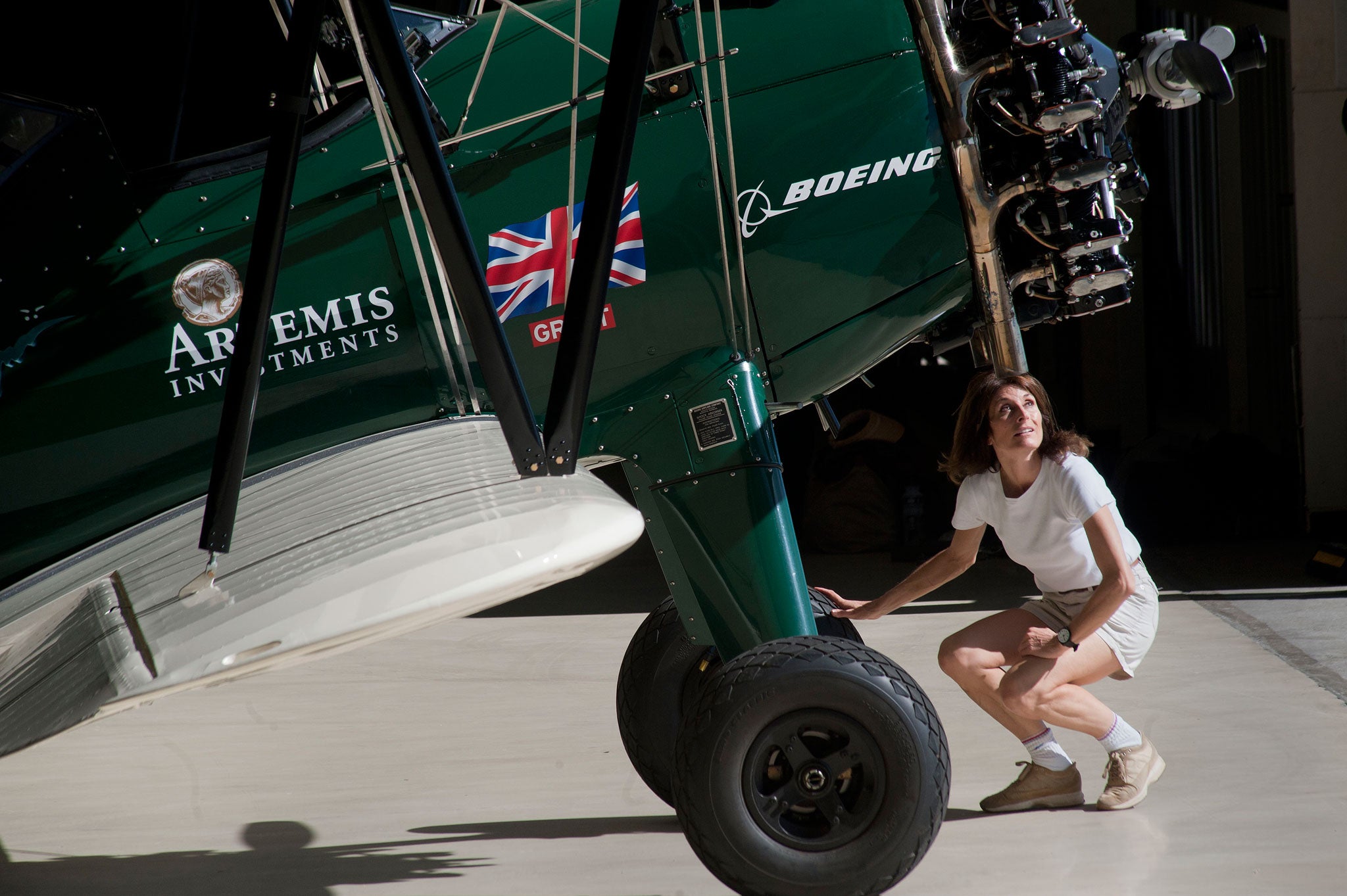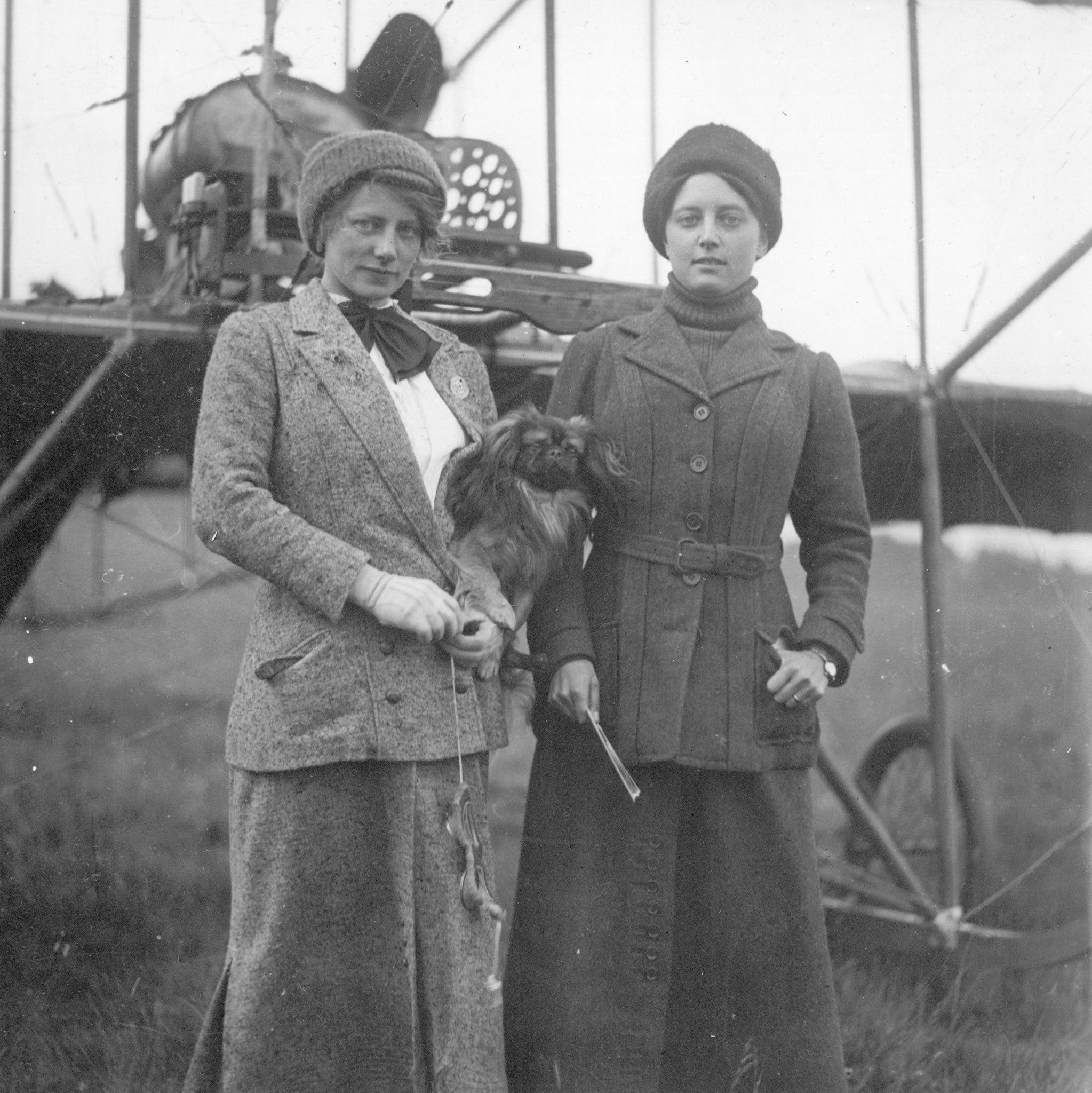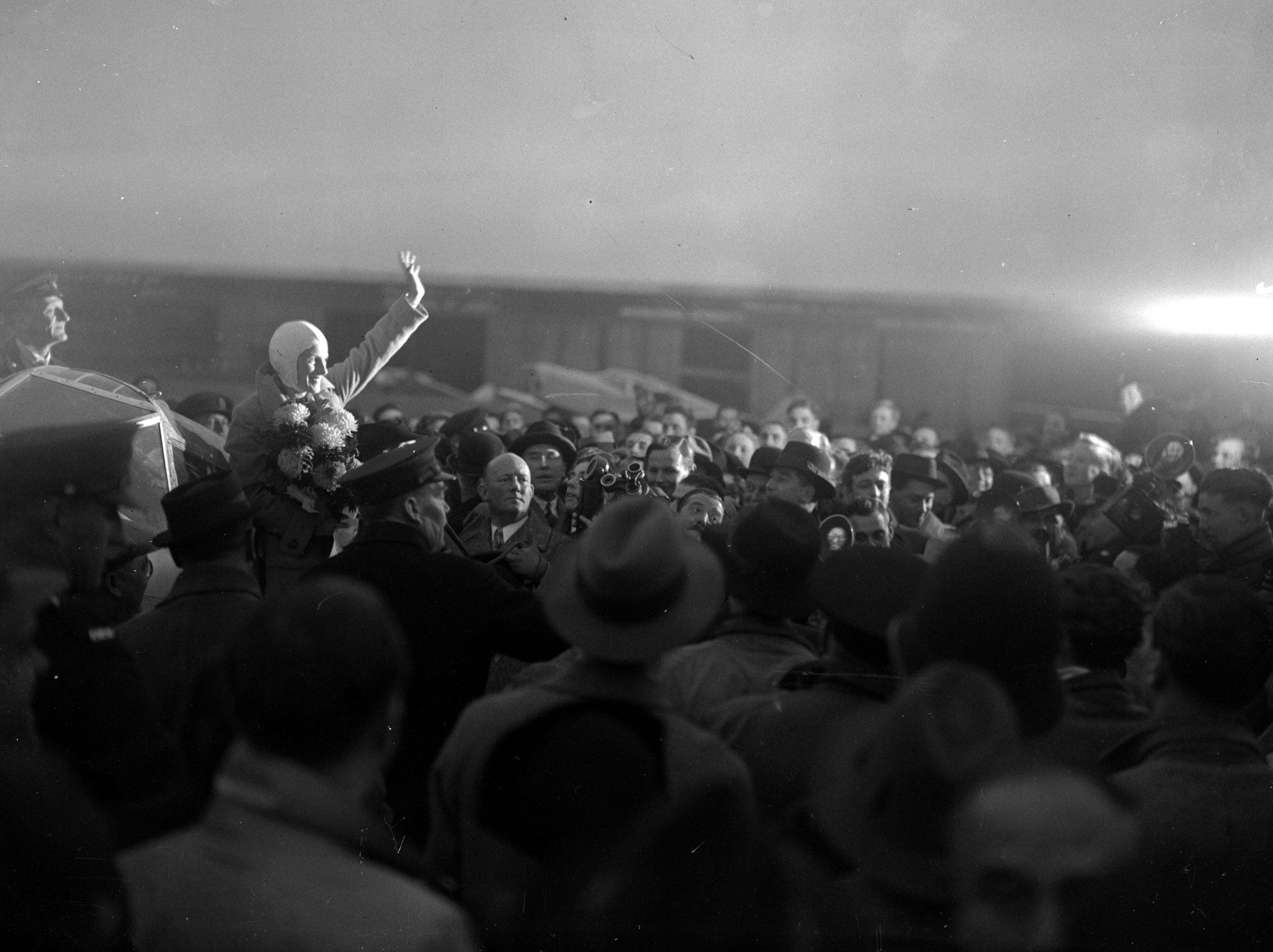Flying through the glass ceiling: Saluting Britain's intrepid female aviators
A British woman is currently winging her way from South Africa to the UK in a Thirties-style biplane. But she isn't the first 'aviatrix' to take on such a challenge...
In a little less than two weeks – all being well – Tracey Curtis-Taylor will land a plane in Goodwood, West Sussex, having piloted it from Cape Town. Nothing remarkable about that, you might think. But Curtis-Taylor's journey is rather special: she's flying solo in a 1930s-style Boeing Stearman biplane, which goes at a top speed of merely 95mph – good job really, because its open cockpit means she gets blasted and buffeted by the elements. This 7,000-mile journey from South Africa to the UK will take around six weeks; she will hopefully land on 18 December.
It's not just about tackling the physical challenges, or for the love of vintage aircraft – she's also celebrating and highlighting a pioneering female aviator. For Curtis-Taylor is not the first woman to make this journey; in 1928, Lady Mary Heath completed the task in the same kind of plane. She was the first pilot – male or female – to fly solo from Cape Town to Britain, a feat which attracted media interest around the world, much of it fascinated by the fact that it was a pair of delicate lady-hands on the controls.
Eighty-five years later, we might like to think we've moved on and up, flying over those glass ceilings into a world where a can-do woman is no more unusual than a man. But Curtis-Taylor was in part inspired to recreate Heath's trailblazing travels because aviation is still "one of those activities which is so male-dominated".
British Airways didn't have any female pilots until 1987 and the RAF not until 1990. Fifty-one-year-old Curtis-Taylor was unable to even consider that as a career path. Instead, she got a commercial license and became a flying instructor, as well as quickly developing an interest in vintage planes. But female pilots are still comparatively rare creatures – and even scarcer in the world of historical vehicle enthusiasts.

Speaking over the phone from South Sudan – a particularly challenging part of the journey, given she's about to fly over what is "effectively a war zone" – Curtis-Taylor commented: "All aspects of aviation are male-dominated. But I got into flying vintage aeroplanes early on and it became a real passion. There are probably a handful of women in the world who've done that sort of flying – and it really is a handful – but something like this, a recreation of a historic flight, is almost unique."
Yet in the early days of aviation, Britain had quite a clutch of bold, brave, brilliant women, who saw that flying could be fun and wanted a bit of the action, even at risk to both life and limb. They often became famous for their derring-do; the press might not have thought piloting a plane was wholly ladylike, but by golly, it made for some cracking – if frequently also tragic – stories, and the public lapped them up.
It was hearing one of these stories, about Heath, that gave Curtis-Taylor the real impetus for her retro odyssey. "I'd had the idea of flying up Africa for a long time; it's one thing to go buzzing up a continent, but I wanted to give it some historical context. It's that glass-ceiling thing: [flight] is symbolic, it's aspirational. It's about risk and doing your own thing – and those female aviators of the 1920 and Thirties, they cut really dashing figures."
They certainly did, often accessorising their peerless engineering skills and fearless enthusiasm with a lick of glamour or spot of theatrics.
Edith Maud Cook
1878-1910
The first-ever British woman to fly – and quite a character. She was born in Ipswich, and later claimed in an interview to have run away from home at the tender age of 14 in order to fly a balloon. True or not, by the time she hit 20, she had certainly achieved her dreams. She applied for the job of 'lady parachutist' for the Spencer Brothers, a pair who achieved fame doing parachute demonstrations around Britain. Cook's role sounds alarming: she would hold on to a trapeze as a hot air balloon ascended several thousand feet, then pull her parachute cord and float back down to the excited waiting crowds. She achieved considerable notoriety, with newspapers eagerly reporting on the 300-odd ascents and jumps she completed.
In 1909, she embarked on the next stage of her flying career, training to be a pilot in France, at the flying school of Louis Blériot – just six months after he became the first man to fly across the Channel – and later with the Brit, Claude Grahame-White. These very early > days of flight were filled with risks, and you needed sacks of courage as well as skill. But Cook took to it with gusto and was a true pioneer for women all over the world, being one of the very first to take control in the cockpit.
Not everyone approved of such an unconventional role for a young woman. Cook needed to keep her identity hidden from the customers of her father's bakery business, according to the Suffolk Aviation Heritage Group, whose invaluable research into her life has raised the profile of this early aviatrix (they're currently fundraising for a statue of Cook in her home town of Ipswich).
To fly and parachute incognito, she assembled a splendid selection of fake names. Thus Edith became the slightly more glamorous Viola, and adopted surnames including Kavanagh, Spencer and – aptly – Fleet. Sadly, she died young, in 1910, when a change in direction of the wind during a parachute jump landed her on a factory roof, breaking her pelvis.

Cheridah de Beauvoir Stocks
1887-1971
Many early female aviators were from well-to-do families, with enough spare cash to fund this thrilling new hobby. One such woman was Cheridah de Beauvoir Stocks, a member of the countryside gentry. Flying was fashionable among her circle – with the chaps, at least – and she took it up too, training at the Grahame-White flying school in Hendon. She was the second British women (after Hilda Hewlett) to obtain a formal aviator's certificate, from the Royal Aero Club in 1911. In her book on female fliers, Before Amelia, Eileen F Lebow writes that Stocks was "social, charming and considerably younger than Hilda Hewlett" – she was only 24 when she netted that certificate, flying a Farman biplane.
Stocks became a regular presence at air races and meets at Hendon – even if she was often the sole female competitor – and was cheered on by crowds as she piloted a Blériot monoplane. She was a cheerful spectator herself, too, and an enthusiastic co-flier with male chums. But aviation was a dangerous business, and in 1913, when flying with the (equally splendidly-named) pilot Sydney Pickles at Hendon, the pair came a cropper when his plane span out of control. They crash-landed, Pickles smashing up his leg, while Stocks remained unconscious for several days at the Central London Sick Asylum.
Stocks recovered, but flying was no longer an option – she was paralysed down her right side. However, she forged a new career as an anthropologist, and remained interested in flying throughout her life. And it was an indisputable fact that she had been a blazing > ambassador for other young women – her obituary in The Times reported that she was "a most beautiful woman and her vivacious character and her exploits won her much popularity".
Elsie Mackay
1893-1928
Another posh gal – and a dramatic one at that. As the Honourable Elsie Mackay, daughter of Lord Inchcape of Glenapp in Scotland, she was one of the wealthiest young women in Britain.
Her life trajectory was never meant to be acting and aviation, but young Mackay fell in love with an actor, Dennis Wyndham, and – to the dismay of her parents – they got married. She adopted the name Poppy Wyndham, and the bohemian life of an actress, appearing on stage and in various silent films, before the marriage was annulled in 1922.
She dabbled, as any young aristo of good taste might, in interior design, primarily tricking out the insides of her father's ships – he was chairman of P&O, handily. But she still had a feisty spirit, and was well-known for her love of galloping about on horses, driving fast in cars and zooming off in airplanes. She bought her own, and was often seen flying over the hills of South Ayrshire.
Jayne Baldwin, whose book West Over the Waves sought to re-appraise this avid flyer, has documented Mackay's fearless penchant for in-air stunts. She once asked a pilot she was flying with to loop the plane: "During the exploit, Elsie's safety strap had broken and while she gripped the bracing wires her body swung out of the plane like a stone on the end of a string. The pilot returned the plane, with difficulty, to the ground and found that Elsie's hands had been cut to the bone due to her fearsome grip of the wires." Apparently, she remained uncowed by the experience.
Mackay decided in 1928 that she was going to fly across the Atlantic – the more difficult way, naturally, going from East to West against the prevailing winds, which had yet to be successfully attempted. She set off in March, flying with an ace (if one-eyed) pilot, Captain Hinchliffe – in secret. She knew her ma and pa would most certainly not approve, so they set off while they were on holiday in Egypt.
Not that the pair managed to keep it much of a secret: there was feverish speculation in the press, with newshounds following their pre-flight moves. The truth quickly got out; Time magazine wrote: "Elsie Mackay, madcap daughter of James Lyle Mackay, Viscount Inchcape of Strathnaver, muffled herself almost beyond recognition and stealthily departed with one-eyed Capt Walter GR Hinchliffe on the treacherous > flight across the Atlantic, Westward." Treacherous it sadly proved to be: the pair were never seen again.
Lady Mary Heath
1896-1939
The inspiration for Curtis-Taylor's flight is a truly remarkable woman, her life story having more twists and turns than a Hollywood melodrama. Born Sophie Catherine Theresa Mary Peirce-Evans, when she was a baby, her father murdered her mother, leaving the young Sophie to be brought up by relatives in Ireland. She showed a fierce spirit – and an aptitude for handling machines – from a young age, driving an ambulance in the First World War. She went on to become a winning athlete, competing in both javelin and high jump, and helped female athletics to gain Olympic status.
Later, her attention turned to flying, and she was the first woman ever to secure a commercial pilot's license in 1926. The following year, she also acquired her Lady title when she strategically married her second husband – Sir James Heath, considerably older and wealthier (flying was not a cheap passion). And in 1928, Heath completed the stunning solo flight from Cape Town to Goodwood. According to Lindie Naughton, author of Lady Icarus, she was front-page news and dubbed 'Britain's Lady Lindy' – the female equivalent of the aviator Charles Lindbergh.
Lady Heath appears to have been media-savvy; she might be hands-on and no-nonsense, but she also knew how to dress the part and win the public's hearts. Many images show her climbing into cockpits in high heels or straddling planes swathed in furs, simply oozing glamour; on her flight through Africa, she made sure she packed evening gowns and silk stockings to change into for social engagements en route...
However, things didn't work out with her husband – or with her ambitions to fly for a commercial airline, which was resistant to the idea of a woman doing the job. Instead, she swept off to America, without her husband but with the intention of making a career cashing in on her unusual status as a titled lady aviator. However, Heath was badly injured when her aircraft stalled and crashed through a roof in 1929. She eventually returned to Ireland (with husband number three) to convalesce and set up their own (not very successful) aircraft company; she never fully recovered from her injuries, however, and later struggled with alcoholism. She died young, after falling from a tram in London.

Amy Johnson
1903-1941
One of the more famous British women pilots, Amy Johnson knew how to think big. Really big. She became the first female pilot to fly solo from the UK to Australia – at the age of just 26.
The daughter of a successful fish merchant, Amy Johnson was born in Hull and (unusually for a woman at the time) gained an economics degree from Sheffield University. It was when she moved to London that she began to fly, becoming a member of the London Aeroplane Club at Stag Lane. She jacked in a steady job as a typist so she could dedicate more time to aviation. It paid off: in 1929, she gained a pilot's license and became the first woman to gain a ground engineer's license.
Despite having only flown around the British Isles before, in May 1930 she embarked on the flight from Croydon to Darwin, Australia in a second-hand De Havilland Gipsy-Moth.
She arrived 20 days later, by which time the public had taken Amy and her plane, Jason, to their hearts; she received thousands of letters and telegrams – including one from Blériot that read simply "Bravo". She was awarded £10,000 from the Daily Mail for her bravery.
A celebrity had landed. As Carol Dyhouse puts it in her book Girl Trouble: "Amy was glamorous. She had dyed her hair blonde and was petite with a girlish figure. This, combined with her somewhat reckless courage, endeared her to many. The newspapers were full of her. A number of popular songs (including 'Amy, Wonderful Amy') celebrated her exploits."
Aviation accidents weren't always wholly tragic; Johnson managed to crash headlong – almost literally – into a love affair. While touring Australia, an accident while landing her plane resulted in her meeting Jim Mollison, another pioneering pilot, who became her husband in 1932. The two flew many long-distance trips together, and rivalled each other in record-breaking – Johnson's own solo flight to Cape Town saw her breaking Mollison's record for the same journey by over 10 hours. But the marriage didn't last – he was something of a womaniser – and they parted ways in 1936, with Johnson soon reclaiming her maiden name.
Johnson had better luck than Heath in getting commercial work, although it was still a struggle, and her airline career was curtailed by the Second World War. So she joined the Air Transport Auxiliary, moving aircraft from factories to Royal Air Force units. It was while delivering an Airspeed Oxford to Kidlington in Oxfordshire in January 1941 that Johnson disappeared. She insisted on flying, despite terrible conditions – reckoning she could "smell her way" – but many hours later both she, in a parachute, and her plane, landed in the Thames estuary, 100 miles off-course. She was spotted by sailors but disappeared before she could be rescued.
Conspiracy theories – as with Amelia Earhart's disappearance – abound about Johnson's death, including suggestions that she faked it, or that she was speeding a spy out of the country and her plane was deliberately shot down. However, the Royal Air Force website claims the most likely explanation is that she "ran out of fuel while trying to find her way through the appalling weather and decided to bale out". Either way, Johnson's story – like so many of the early aviatrixes – is still quite extraordinary.
A documentary about Tracey Curtis-Taylor and Lady Mary Heath's journeys will be released next spring (capetowntogoodwood.com); for more on the Edith Maud Cook statue campaign, visit suffolkaviationheritage.org.uk
Click here to view the latest travel offers, with Independent Holidays.
Join our commenting forum
Join thought-provoking conversations, follow other Independent readers and see their replies
Comments